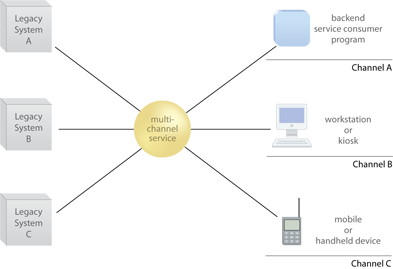SOA Patterns > Legacy Encapsulation Patterns > Multi-Channel Endpoint
Multi-Channel Endpoint (Roy)
How can legacy logic fragmented and duplicated for different delivery channels be centrally consolidated?

Problem
Legacy systems custom-built for specific delivery channels (mobile phone, desktop, kiosk, etc.) result in redundancy and application silos when multiple channels need to be supported, thereby making these systems burdensome to govern and difficult to federate.
Solution
An intermediary service is designed to encapsulate channelspecific legacy systems and expose a single standardized contract for multiple channel-specific consumers.
Application
The service established by this pattern will require significant processing and workflow logic to support multiple channels while also coordinating interaction with multiple backend legacy systems.
Impacts
The endpoint processing logic established by this pattern often introduces the need for infrastructure upgrades and orchestration-capable middleware and may turn into a performance bottleneck.
Principles
Architecture
Service

The multi-channel service acts as the central contact point for different channel-based solutions (right) and legacy systems (left).
Related Patterns in This Catalog
Composition Autonomy, Contract Centralization, Data Format Transformation, Data Model Transformation, Legacy Wrapper, Process Abstraction, Protocol Bridging, Redundant Implementation
Related Service-Oriented Computing Goals
Increased Business and Technology Alignment, Increased Intrinsic Interoperability, Reduced IT Burden
This page contains excerpts from:
SOA Design Patterns by Thomas Erl
(ISBN: 0136135161, Hardcover, Full-Color, 400+ Illustrations, 865 pages)
For more information about this book, visit www.arcitura.com/books.
